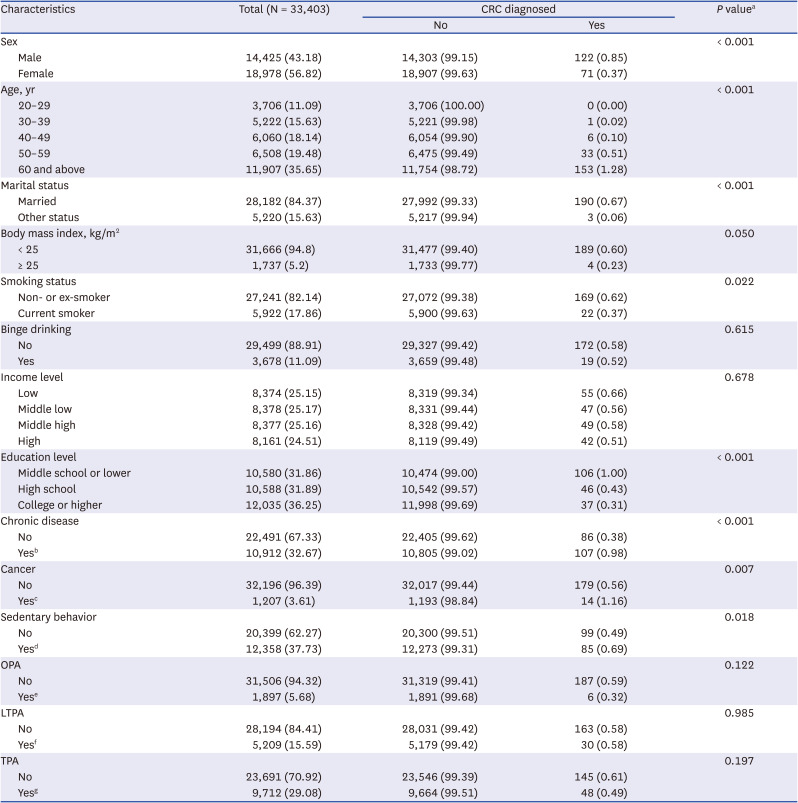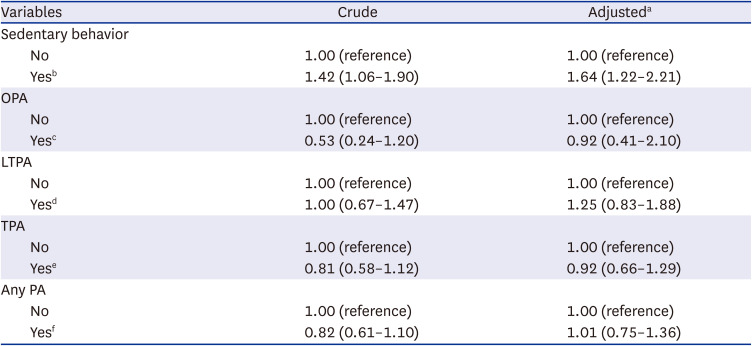1. Rawla P, Sunkara T, Barsouk A. Epidemiology of colorectal cancer: incidence, mortality, survival, and risk factors. Prz Gastroenterol. 2019; 14(2):89–103. PMID:
31616522.
2. Khil H, Kim SM, Hong S, Gil HM, Cheon E, Lee DH, et al. Time trends of colorectal cancer incidence and associated lifestyle factors in South Korea. Sci Rep. 2021; 11(1):2413. PMID:
33510236.
3. Sierra MS, Forman D. Burden of colorectal cancer in Central and South America. Cancer Epidemiol. 2016; 44(Suppl 1):S74–S81. PMID:
27678325.
4. Nam S, Choi YJ, Kim DW, Park EC, Kang JG. Risk factors for colorectal cancer in Korea: a population-based retrospective cohort study. Ann Coloproctol. 2019; 35(6):347–356. PMID:
31937075.
5. Friedenreich CM, Ryder-Burbidge C, McNeil J. Physical activity, obesity and sedentary behavior in cancer etiology: epidemiologic evidence and biologic mechanisms. Mol Oncol. 2021; 15(3):790–800. PMID:
32741068.
6. Tremblay MS, Aubert S, Barnes JD, Saunders TJ, Carson V, Latimer-Cheung AE, et al. Sedentary Behavior Research Network (SBRN) - Terminology Consensus Project process and outcome. Int J Behav Nutr Phys Act. 2017; 14(1):75. PMID:
28599680.
7. Park JH, Moon JH, Kim HJ, Kong MH, Oh YH. Sedentary lifestyle: overview of updated evidence of potential health risks. Korean J Fam Med. 2020; 41(6):365–373. PMID:
33242381.
8. Byun W, Dowda M, Pate RR. Associations between screen-based sedentary behavior and cardiovascular disease risk factors in Korean youth. J Korean Med Sci. 2012; 27(4):388–394. PMID:
22468102.
9. Park MS, Chung SY, Chang Y, Kim K. Physical activity and physical fitness as predictors of all-cause mortality in Korean men. J Korean Med Sci. 2009; 24(1):13–19. PMID:
19270807.
10. Kerr J, Anderson C, Lippman SM. Physical activity, sedentary behaviour, diet, and cancer: an update and emerging new evidence. Lancet Oncol. 2017; 18(8):e457–e471. PMID:
28759385.
11. Strath SJ, Kaminsky LA, Ainsworth BE, Ekelund U, Freedson PS, Gary RA, et al. Guide to the assessment of physical activity: clinical and research applications: a scientific statement from the American Heart Association. Circulation. 2013; 128(20):2259–2279. PMID:
24126387.
12. Holtermann A, Hansen JV, Burr H, Søgaard K, Sjøgaard G. The health paradox of occupational and leisure-time physical activity. Br J Sports Med. 2012; 46(4):291–295. PMID:
21459873.
13. Park CS, Ha KH, Kim HC, Park S, Ihm SH, Lee HY. The association between parameters of socioeconomic status and hypertension in Korea: the Korean genome and epidemiology study. J Korean Med Sci. 2016; 31(12):1922–1928. PMID:
27822930.
14. Armstrong T, Bull F. Development of the world health organization global physical activity questionnaire (GPAQ). J Public Health. 2006; 14(2):66–70.
15. Jeon JY. Development of the KOREAN Version of Global Physical Activity Questionnaire and Assessment of Reliability and Validity. Osong, Korea: Korea Center for Disease Control and Prevention;2013.
16. An SY, Kang HE, Kim SM, Sok SA, Yang HJ, Lee GN. Association between sitting time and diabetes mellitus, cardiovascular disease and metabolic syndrome in Korean: the sixth Korean National Health and Nutrition Examination Survey 2013 and 2014. Korean J Fam Pract. 2017; 7(4):588–595.
17. Lee Y, Son JS, Eum YH, Kang OL. Association of sedentary time and physical activity with the 10-year risk of cardiovascular disease: Korea National Health and Nutrition Examination Survey 2014–2017. Korean J Fam Med. 2020; 41(6):374–380. PMID:
32008313.
18. Lee SY, Son DH, Lee YJ. Relationship between sedentary time and handgrip strength in healthy Korean women: Korea National Health and Nutrition Examination Survey 2014–2016. Korean J Fam Med. 2020; 41(6):422–426. PMID:
31902197.
19. Patel AV, Hildebrand JS, Campbell PT, Teras LR, Craft LL, McCullough ML, et al. Leisure-time spent sitting and site-specific cancer incidence in a large US cohort. Cancer Epidemiol Biomarkers Prev. 2015; 24(9):1350–1359. PMID:
26126627.
20. Li Y, Eshak ES, Cui R, Shirai K, Liu K, Iso H, et al. Television viewing time and the risk of colorectal cancer mortality among Japanese population: the JACC study. Cancer Res Treat. 2021; 53(2):497–505. PMID:
33138348.
21. Ma P, Yao Y, Sun W, Dai S, Zhou C. Daily sedentary time and its association with risk for colorectal cancer in adults: a dose-response meta-analysis of prospective cohort studies. Medicine (Baltimore). 2017; 96(22):e7049. PMID:
28562564.
22. Eaglehouse YL, Koh WP, Wang R, Aizhen J, Yuan JM, Butler LM. Physical activity, sedentary time, and risk of colorectal cancer: the Singapore Chinese Health Study. Eur J Cancer Prev. 2017; 26(6):469–475. PMID:
28542077.
23. Gorczyca AM, Eaton CB, LaMonte MJ, Garcia DO, Johnston JD, He K, et al. Association of physical activity and sitting time with incident colorectal cancer in postmenopausal women. Eur J Cancer Prev. 2018; 27(4):331–338. PMID:
28538039.
25. Patel AV, Friedenreich CM, Moore SC, Hayes SC, Silver JK, Campbell KL, et al. American College of Sports Medicine roundtable report on physical activity, sedentary behavior, and cancer prevention and control. Med Sci Sports Exerc. 2019; 51(11):2391–2402. PMID:
31626056.
26. Helmerhorst HJ, Wijndaele K, Brage S, Wareham NJ, Ekelund U. Objectively measured sedentary time may predict insulin resistance independent of moderate- and vigorous-intensity physical activity. Diabetes. 2009; 58(8):1776–1779. PMID:
19470610.
27. Ryu TY, Park J, Scherer PE. Hyperglycemia as a risk factor for cancer progression. Diabetes Metab J. 2014; 38(5):330–336. PMID:
25349819.
28. Giovannucci E. Insulin, insulin-like growth factors and colon cancer: a review of the evidence. J Nutr. 2001; 131(11):Suppl. 3109S–3120S. PMID:
11694656.
29. Howard BJ, Balkau B, Thorp AA, Magliano DJ, Shaw JE, Owen N, et al. Associations of overall sitting time and TV viewing time with fibrinogen and C reactive protein: the AusDiab study. Br J Sports Med. 2015; 49(4):255–258. PMID:
24550208.
30. Coussens LM, Werb Z. Inflammation and cancer. Nature. 2002; 420(6917):860–867. PMID:
12490959.
31. Gleeson M, Bishop NC, Stensel DJ, Lindley MR, Mastana SS, Nimmo MA. The anti-inflammatory effects of exercise: mechanisms and implications for the prevention and treatment of disease. Nat Rev Immunol. 2011; 11(9):607–615. PMID:
21818123.
32. Hojman P, Gehl J, Christensen JF, Pedersen BK. Molecular mechanisms linking exercise to cancer prevention and treatment. Cell Metab. 2018; 27(1):10–21. PMID:
29056514.
33. Holtermann A, Burr H, Hansen JV, Krause N, Søgaard K, Mortensen OS. Occupational physical activity and mortality among Danish workers. Int Arch Occup Environ Health. 2012; 85(3):305–310. PMID:
21695437.
34. Päivärinne V, Kautiainen H, Heinonen A, Kiviranta I. Relations between subdomains of physical activity, sedentary lifestyle, and quality of life in young adult men. Scand J Med Sci Sports. 2018; 28(4):1389–1396. PMID:
29095553.
35. Omorou AY, Vuillemin A, Menai M, Latarche C, Kesse-Guyot E, Galan P, et al. 10-year cumulative and bidirectional associations of domain-specific physical activity and sedentary behaviour with health-related quality of life in French adults: Results from the SU.VI.MAX studies. Prev Med. 2016; 88:66–72. PMID:
27058941.
36. Arem H, Moore SC, Patel A, Hartge P, Berrington de Gonzalez A, Visvanathan K, et al. Leisure time physical activity and mortality: a detailed pooled analysis of the dose-response relationship. JAMA Intern Med. 2015; 175(6):959–967. PMID:
25844730.
37. Mahmood S, MacInnis RJ, English DR, Karahalios A, Lynch BM. Domain-specific physical activity and sedentary behaviour in relation to colon and rectal cancer risk: a systematic review and meta-analysis. Int J Epidemiol. 2017; 46(6):1797–1813. PMID:
29025130.
38. Morris JS, Bradbury KE, Cross AJ, Gunter MJ, Murphy N. Physical activity, sedentary behaviour and colorectal cancer risk in the UK Biobank. Br J Cancer. 2018; 118(6):920–929. PMID:
29520109.








 PDF
PDF Citation
Citation Print
Print




 XML Download
XML Download